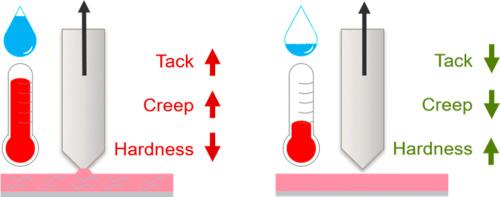Progress in Organic Coatings ( IF 6.6 ) Pub Date : 2021-12-15 , DOI: 10.1016/j.porgcoat.2021.106657 J.L. Hall 1, 2 , A. Pérez 3 , E.L. Kynaston 2 , C. Lindsay 2 , J.L. Keddie 1

|
Waterborne colloidal polymer coatings are widely used in architectural and agricultural applications where they are subject to challenging environments, such as extremes of temperatures and relative humidities (RH). This research investigates the effects of adding two common co-formulants, poly(acrylic acid) (PAA) and xanthan gum (XG), to waterborne polymer composite coatings in these environments. The mechanical properties of the resulting coatings are of particular interest. Hardness, creep and tack properties of thick (~400 μm) formulated model coatings were characterized using a micro-indentation technique operating in a single cycle within a bespoke environmental chamber. Measurements were made at three temperatures (16, 20 and 30 °C), which span the glass transition temperature (Tg) of the acrylic copolymer binder, and over three RH values of 10%, 43%, and 90%. The creep data were analysed using the Burgers model to extract characteristic viscoelastic properties. The tack was found by recording the force when withdrawing the probe from the sample and using it to obtain nominal stress (knowing the indentation depth and probe geometry) during the indenter's withdrawal and hence the work of adhesion (WAdh) to detach from the coating. Tack adhesion is completely lost below the binder's Tg but increases when the ambient temperature increases. In formulated coatings, both the tack and creep deformation increase as the relative humidity increases, and this trend is observed at each temperature. There is no evidence from thermal analysis for plasticization of the acrylic polymer by moisture sorption, but the two co-formulants are hydrophilic. The observed softening of the coatings at high RH can be attributed to water sorption in the components. The presence of glassy PAA has the effect of raising the hardness of glassy coatings, but only at low RH when there is no plasticization by water. The addition of hydrophilic XG surprisingly reduces tack adhesion while also raising the viscosity of the coating. These findings will inform the formulation of waterborne colloidal coatings to function in a range of environments.
中文翻译:

环境条件对水性涂料微机械性能的影响
水性胶体聚合物涂料广泛用于建筑和农业应用,在这些应用中它们会受到具有挑战性的环境,例如极端温度和相对湿度 (RH)。本研究调查了在这些环境中向水性聚合物复合涂料中添加两种常见助剂聚丙烯酸 (PAA) 和黄原胶 (XG) 的效果。所得涂层的机械性能特别令人感兴趣。厚(~400 μm)配方模型涂层的硬度、蠕变和粘性特性使用微压痕技术在定制的环境室中以单个循环运行进行表征。在三个温度(16、20 和 30 °C)下进行测量,这些温度跨越玻璃化转变温度 ( T g) 的丙烯酸共聚物粘合剂,以及超过三个 10%、43% 和 90% 的 RH 值。使用 Burgers 模型分析蠕变数据以提取特征粘弹性。通过记录从样品中拔出探针时的力并使用它来获得压头拔出期间的标称应力(知道压痕深度和探针几何形状)并因此获得与涂层分离的粘附功 ( W Adh ) 来确定粘性. 低于粘合剂的T g 时,粘性完全丧失但随着环境温度升高而增加。在配制的涂料中,粘性和蠕变变形都随着相对湿度的增加而增加,并且在每个温度下都观察到这种趋势。没有来自热分析的证据表明丙烯酸聚合物通过吸湿而塑化,但是这两种共配方是亲水的。在高 RH 下观察到的涂层软化可归因于组件中的水吸附。玻璃态PAA的存在具有提高玻璃态涂层硬度的作用,但仅在没有水增塑的低RH下。亲水性 XG 的加入令人惊讶地降低了粘性,同时还提高了涂层的粘度。这些发现将为水性胶体涂料的配方提供信息,以在一系列环境中发挥作用。



























 京公网安备 11010802027423号
京公网安备 11010802027423号